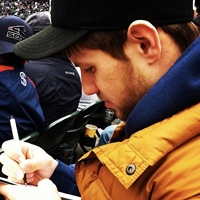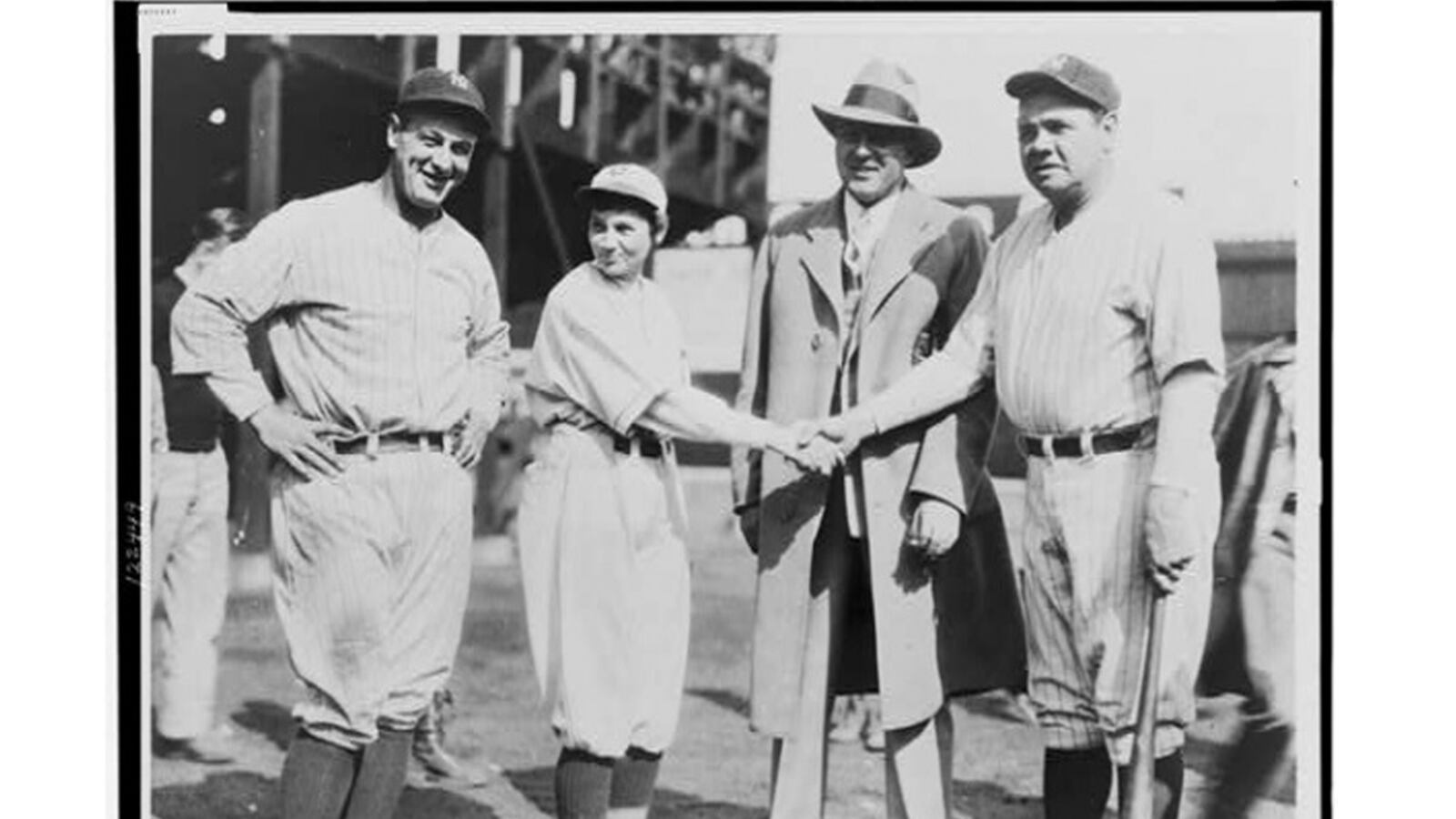You're reading one of the six stories in the first issue of The Classical Magazine. You can find us every day on the web at theclassical.org, but we’ve partnered with 29th Street Publishing to create a magazine with the idea of making our brand of journalism sustainable through the revolutionary act of selling it, for money. We hope you’ll buy it. It’s $2.99 if you pay monthly, $29.99 if you sign up for a year in advance, and $3.99 to buy individual issues.

On one side of the photo stood Babe Ruth, his portly frame draped in familiar Yankee pinstripes. Next to him was a small woman dressed in two-toned stirrups and a baggy baseball jersey, a ball cap shielding her dark, curly hair. The disparate pair was shaking hands. Joseph Wallace—author of two baseball history books and working on a third—had no clue what he was looking at. He was deep in the archives at the Baseball Hall of Fame in Cooperstown, thumbing through a generic file about women in baseball. He wanted to know more about the mystery lady ballplayer.
So he tracked down Tim Wiles, the Hall of Fame’s Director of Research. Wiles took one look at the snapshot and led Wallace to a small bookstore outside the library’s front door. On a shelf in the children's section sat a picture book, and its cover featured a cartoon pitcher who looked identical to the woman in Wallace’s photograph, down to the hat. Wiles said the woman’s name was Jackie Mitchell. A blunt title—The Girl Who Struck Out Babe Ruth—was splashed across the top in big blue letters.

The book told an amazing story. In the spring of 1931, a 17-year-old female signed a professional contract with a men’s minor league team in Chattanooga and, in the first inning of her first professional game, struck out Ruth and slugger Lou Gehrig consecutively. “She could put speed on the ball,” the book read. “She had control. And somehow, she could always guess a batter’s weakness.” Flipping through the pages, Wallace wondered how he’d never heard about Mitchell before, and why her triumphant outing wasn’t one of those canonical anecdotes fans of America’s most nostalgic game commit to memory. Eventually, a second thought entered his mind: Is there any way in hell this story could be true?
Andy Broome was similarly skeptical. A baseball card grader for Beckett Media and a Chattanooga native, Broome first heard about Mitchell’s feat from his great-grandfather, who talked about seeing the teen toe the rubber while he was a young man. In 2000, Broome became consumed by what he guessed was a tall tale. For half a decade, he scanned newspaper clippings, sought out collectibles from the April 2, 1931 game, and crisscrossed the country interviewing players who were still alive and had played with her, as well as friends and acquaintances who knew her later in life.“I was trying to find out, as much as I could, what was true and what had grown over the years from being retold countless times,” he says. “I went into it expecting to dig up the absolute truth about how everybody was in on it, and it was just a publicity deal.” After spending more time studying Mitchell’s life than anyone ever had, Broome reached a pair of conclusions. First, given the magnitude of the alleged achievement, the Mitchell paper trail was shorter than he expected. What evidence he could find didn’t necessarily support a hoax theory. “I went down as far as anyone has,” he says, “and I think it was a real deal.”
Here, thanks to decades-old newspaper reports, is what we know generally about the girl who struck out the Iron Horse and the Babe. Virne Beatrice “Jackie” Mitchell was born on August 29, 1913. (The 1920 U.S. Census indicates she was born in 1912, but there’s no reason to believe she would lie about her age as a young adult.) She was raised by her mother, who sold hosiery, and her father, a supportive and athletically minded optician who encouraged his daughter to swim and play ball at an early age. When Jackie was a toddler, the Mitchells moved to Memphis, and by coincidence, into the same building as Dazzy Vance, a Dodger great who won the NL MVP award in 1924 and struck out over 2,000 hitters in his 16-year career. Vance—then playing for the Memphis Chicks—took a liking to his tiny neighbor, teaching her how to throw a “drop ball,” now known as a sinker, among other tricks.
Mitchell was not burly, standing roughly 5’5” and weighing no more than 130 pounds. A reporter with the Middletown Times Herald found her “distinctly feminine.” (Mitchell wasn’t “one of these stuck-up, temperamental woman athletes possessed with a sense of her own importance and hard to get along with,” the Atlanta Constitution once mansplained. “She’s a shy little girl, who blushed under her sun-burned face when asked her full name.”) She was, however, coordinated and tough. By all accounts, Mitchell excelled on the hardwood and on the diamond, suiting up for a traveling basketball team in the winter and for a Chattanooga women's baseball team in the spring and summer. According to her father’s own scouting report at the time, Mitchell “has one of the most deceptive pitching deliveries, hits fair, and fields way above the average that a boy of her age can field.” In early 1931, she briefly attended a baseball training school in Atlanta, where the lefthander caught the eye of Joe Engel, chief scout of the Washington Senators and president of the Chattanooga Lookouts, a AA club in the Southern Association. It was Engel who would give Mitchell her big break.
Engel had taken over the club in 1929, just months before the stock market crash sent the country spiraling into depression. Selling tickets required creative marketing. “He was a master of promotion,” says Janna Jahn, chair of the Engel Foundation, a Chattanooga-based non-profit working to refurbish the Lookouts’ old stadium. “Joe created at Engel Stadium the intersection between vaudeville and baseball.” His CV is downright Veeckian. With the help of the Chattanooga Times, Engel once raffled off a house to a lucky ticket holder. He traded a much-maligned shortstop for a 25-pound turkey, which he promptly served to the team’s beat reporters. (They had been “giving him the bird” all season, he later said.) When the Senators’ owner Clark Griffith considered putting the Lookouts on the market in 1937, the "Barnum of Baseball” stood on street corners in town and sold stakes in his new “fan-owned club,” at $5 per share, to over 1,500 locals. (The gambit helped convince management not to sell.) On Opening Day the following year, he staged a papier-mâché elephant hunt on the field, sending safari-clad trappers to chase men in pachyderm suits. In the spring of 1931, less than a week before the mighty Yankees were scheduled to stop in Chattanooga for an exhibition game, Engel decided to award a teen girl a coveted spot on his roster.
When she heard the news, Mitchell “sped eastward by bus from Dallas,” where she’d been playing in a basketball tournament. She signed a formal contract with the Lookouts, becoming the second woman ever to join a minor league team, wearing a “white colored gown, a chic little hat, and a snug leather jacket.” Her mother would accompany her on all road trips, reports assured nervous readers, and Mitchell hoped the money would help pay for college tuition. “This chance is an answer to a dream,” she told the UP. “I have to make good.”
But first, she’d have to work her arm into shape, and on short notice. Mitchell hadn’t thrown regularly since the fall, having spent the winter months hooping instead. The Yankees were to roll into town on April 1. It’s not clear how much she practiced over the next few days, but the Washington Post reported at the time that she had been “laid up with a sore arm,” suggesting the southpaw might have pushed herself too hard in anticipation of the big game. Bad weather, however, gave her a reprieve; a spring rainstorm forced a postponement, pushing her appearance back 24 hours.
On April 2, 1931, Mitchell buttoned up a wool Lookouts jersey and reported to the team’s bullpen. She met Ruth and Gehrig briefly on the field before the game, posing for pictures with her imposing opponents. (One photo shows the pair standing right behind Mitchell, arms on hips, watching intently as she loosens up.) A crowd of 4,000—eager to see whether she could hold her own against Murderers’ Row—stormed through the turnstiles. They had to wait all of two at-bats to catch Jackie in action. Lookouts starter Clyde Barfoot surrendered a double off the center field wall to leadoff man Earle Combs and a single up the box to Lyn Lary, falling behind by a run within minutes. As Ruth strutted to the plate, Chattanooga’s manager called for the “snip-nosed blue-eyed girl” (Baltimore Sun). “Without so much as powdering her nose or seeing if her lipstick was on straight,” a Washington Post reporter wrote, “Jackie strode to the mound.”
The Great Bambino was waiting. Mitchell took a few warm-up tosses, looked in to her catcher, “wound up as if she were turning a coffee grinder,” and let loose a curveball. Ruth swung through it. He took another big hack at a second breaking ball and missed again. Both Broome and Jahn have seen a segment of the at-bat on restored film. “You can just watch the ball itself,” Broome says. “It’s a hell of a curve.” Ruth demanded the home plate umpire inspect the ball, according to multiple writers on hand. Ahead in the count, Jackie decided to “sail one down the middle—a cripple if there ever was one.” The pitch froze Ruth and cruised over the plate for a perfect third strike. It was, the Post wrote, “the deadliest insult of all.” The New York Times claimed that Ruth “flung his bat away in high disdain and trudged to the bench, registering disgust with his shoulders and chin.” Jahn confirms it: “He does slam down the bat, and he gives the umpire a dirty look.”
Mitchell made uncharacteristically easy work of Gehrig, too, sitting the first basemen down on three pitches. The papers spent fewer inches describing that duel than they did Ruth’s, though the Baltimore Sun suggests “Lou could hear Jackie’s girlfriends squealing delightedly.” The fifth hitter Tony Lazzeri, no slouch himself, watched four pitches miss wide and drew a walk. Mitchell, ostensibly battling that achy arm, was subsequently pulled. (The Post had a different theory: “Jackie probably remembered by that time that she was a woman, and after all the excitement she undoubtedly wanted to go off and have a good cry so they let her retire from the game.”) She walked off the mound to a hail of cheers and watched from the bench as the Bronx Bombers pounded her new teammates en route to a 14-4 victory. Having witnessed her improbable display, nobody in Chattanooga cared a wink about the final result.
Really, though, a tiny teenage woman struck out two of baseball’s biggest stars? In the same inning? “Half think it was one of Engel’s stunts and the other half thinks she really did strike them out, or could have,” Jahn says. “It’s believers and non-believers.” “I’ve heard plenty of opinions,” Broome adds, “and I’ve had people in my face about it.”
The pro-hoax case starts with Engel. Though the Lookouts’ president hadn’t yet pulled off some of his more outlandish exploits, he would show in the ensuing years a willingness to drum up interest in the team by any means necessary. Ruth, too, was famous for performing vaudevillian shenanigans on the off-season barnstorming tours he frequently headlined. Though veteran sportswriter and Ruth biographer Leigh Montville admits he “just steamrolled right past” the Mitchell story during his research, he wouldn’t have put it past Ruth to try some funny stuff in a meaningless game. “He might have asked her for a date,” Montville jokes. Striking out both hitters without their consent just seems like a task too tall for a 130-pound amateur. The previous season, Ruth and Gehrig posted on-base plus slugging percentages of 1.225 and 1.194 respectively, both of which still rank among the top 25 single-season offensive performances in Major League Baseball history. Combined, they only struck out in 9 percent of their at-bats. Coming off spring training, neither player would have been rusty, either. By that point in his career, Montville says Ruth had even started to employ a modest off-season conditioning program.
But Mitchell insisted the strikeouts were legit, until she passed away in 1987. So did Lazzeri, who claims he went to the plate looking to hack. Gehrig, for what it’s worth, was not a man who could be easily bought or persuaded to embarrass himself and the Yankee organization, to which he was supremely loyal. “Gehrig thought the rules had to be strictly obeyed; a man was not entitled to breathe too freely,” wrote Ray Robinson in the 1990 biography Iron Horse. “He adhered to a moral code loftier, certainly, than the Babe’s.”
If either slugger was going whiff, it might well have been in his first at-bat against a lefty with an unorthodox motion and at least some track record of success; though their production didn’t drop dramatically against southpaws during their careers, each fared worse than when they took on right-handers. “If she faced him 100 times, [Ruth] was going to hit plenty of home runs off her,” Wallace speculates. “Do I believe the first time they ever faced each other, that she had the best chance with some sort of pitch that sunk? Yes.”
What happened to Mitchell after that April day is also a bit of a mystery. As the popular tale goes, commissioner Kenesaw Mountain Landis—embarrassed by the spectacle of a lady taking down his superstars—voided her contract with Chattanooga within days, calling baseball “too strenuous for women.” Broome traced the rumor back to a single reporter, “who stated that and it just became fact.” A deep dive into several online news databases didn’t turn up any articles about Landis’ ruling. This is curious, given how much coverage Mitchell garnered when she took the mound against the Yanks.
Throughout that spring, she did suit up consistently for the Chattanooga Junior Lookouts, another club run by Engel that played against semi-pro and town teams throughout the south. On June 27, 1931, the Atlanta Constitution printed a short profile of Mitchell in which her father said she’d already traveled 3,000 miles and pitched in 32 games that summer. After skipping between several low-level minor leagues in 1932, she signed a contract in the spring of 1933 with the House of David, the nation’s most famous and idiosyncratic barnstormers. The hairy commune paid the “typically boyish” hurler $1,000 per month, according to the Times, and allowed her parents to travel with the team. She retired from baseball permanently in 1937 to work in her father’s office.
Why Mitchell’s short and strange career isn’t more celebrated and scrutinized by baseball historians is a question Broome can’t answer. She was a private person, to be sure, and never tried to capitalize on her fame in any coordinated way, which in turn limited the amount of information available about her life. Wallace wonders if the baseball establishment “felt a certain amount of professional discomfort that caused them to jam [the story] into a drawer years ago.” In truth, because it’s impossible to separate fact from myth, Jackie Mitchell’s big day is also an easy story to dismiss.
Mitchell has recently surfaced in several fictional stories, most notably a pair of widely printed (and vaguely feminist) children’s books. Marissa Moss ends Mighty Jackie: The Strike-Out Queen, with this inspirational message: “She’d shown the world how a girl could throw—as hard and as fast and as far as she wanted.” Four years ago, Broome took all of the material he’d collected and used it as background for a Mitchell novella cheekily titled Her Curves Were Too Much For Them. After looking at her photo in the Hall of Fame, Wallace put aside another novel he was writing to work on Ruby Diamond a story set in 1920s Brooklyn and based loosely on Jackie’s life. It was published in 2010.
The author who dug up that photo in Cooperstown appreciates the epistemological puzzle. We might never know how Mitchell fanned two icons of the game, or if she did it under false pretenses. Yet the tale baseball historians have pieced together is gratifying enough for it not to matter.“I love that it hasn't been told so often that all the juice is drained out of it,” Wallace says of Mitchell’s illustrious inning. “You could interpret it six ways. It’s almost a legend.”

The Classical’s new magazine format is available via monthly or yearly subscriptions, as well as single-issue purchases, on the Apple iOS newstand. It’s $2.99 if you pay monthly, $29.99 if you sign up for a year in advance, and $3.99 to buy individual issues. On the second Tuesday of every month, a new issue will appear to delight your senses (mostly/only your eyes) and give you 100% of your recommended daily allowance of adjectives.






